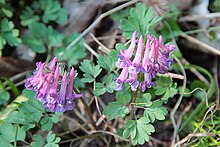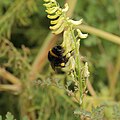|
Corydalis
Corydalis (from Greek korydalís "crested lark") is a genus of about 540 species of annual and perennial herbaceous plants in the family Papaveraceae, native to the temperate Northern Hemisphere and the high mountains of tropical eastern Africa. They are most diverse in China and the Himalayas, with at least 357 species in China. Corydalis spp. are the only dicots having only a single cotyledon (seed leaf).[1] EcologyCorydalis species are used as food plants by the larvae of some Lepidoptera species (butterflies), especially the clouded Apollo. ToxicityCorydalis cava and some other tuberous species contain the alkaloid bulbocapnine, which is occasionally used in medicine but scientific evidence is lacking in the correct dosages and side effects.[2] Many of the species in Corydalis contain other toxins and alkaloids like canadine, which blocks calcium. The species C. caseana is poisonous to livestock.[3] TaxonomyCurrent speciesThere are about 540 species, including:
Former speciesSeveral former Corydalis have been moved to new genera:
ReferencesWikimedia Commons has media related to Corydalis.
|
||||||||||||||||||||||||||||||||
Portal di Ensiklopedia Dunia
























